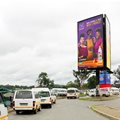So how does a static out-of-home (OOH) media owner stay relevant in a digital world?
With mobile!
Five years ago, we embarked on the journey of pairing the two realms in which consumers exist: online and on the ground. A large part of most buying journeys occurs online, however, online shopping only accounts for 5% of total retail in South Africa. Although we have seen massive growth in this sector since 2021, a substantial 95% of all purchasing still happens through brick-and-mortar stores.
For brands to be present throughout the consumers buying journey they need to be able to jump between these two universes in order to drive conversion, and ultimately an increase in sales. To take it even further, how do we link online and on-the-ground measurables to see a change in consumer behaviour and track the success of our consumer touchpoints?
The answer is a combination of OOH elements coupled with incredibly accurate location-based mobile targeting. Both platforms are location-specific and audience-centric and amplify the success of one another. OOH builds trust and drives 48% higher online engagement (https://broadsign.com/blog/out-of-home-advertising/) while mobile drives higher on-the-ground conversions when coupled with OOH.
Our #Stayhome campaign run during the 2020 lockdown was an excellent illustration of the undeniable synergy between these two platforms. Township malls struggled with kilometer-long queues outside their gates while shoppers waited for hours in line to purchase a small bag of snacks. The malls wanted to encourage shoppers to #Stayhome, so we incentivised shoppers with free data bundles for not visiting the mall. We tracked shopper’s mobile device IPs within the mall catchment area and mall perimeter. Shopper devices seen inside the mall were reminded to stay home, shoppers who stayed away from the mall for five days or more were served a reward ad allowing them to redeem a data bundle through a USSD code.
We ran this identical campaign at two malls in two different townships. Only one township mall had a billboard present to support the campaign. The results showed that while shopper audiences stayed at home, they were reluctant to redeem the free data. However, our reward redemption rate was six times higher in the township where we had a billboard present. Without the billboard, there was very little trust in the legitimacy of the digital campaign. The online engagement was high which shows interest and intent, yet the redemption rate in the township with no billboard to support the campaign, painted a very different picture.
In another campaign with a tech brand, we found that four out of the top five locations with the highest online engagement had a billboard present. We also saw four times higher store visit rates (SVR) in the locations that had billboard advertising present. We could also determine the impact of the digital campaign on the on-the-ground store visits by tracking footfall to local distributors. We saw that one distributor in particular held almost 50% of all the store visits tracked, this was the particular distributor that the mobile ad pushed users to once they engaged online. By overlaying the mobile campaign data with the on-the-ground elements we start to paint a more holistic view of the strategy and the impact of various campaign elements.
OOHMamela Media 1 Mar 2023
A further example of how billboards and mobile amplify the success of one another involves a large cellular network provider. While presenting the post-campaign analysis (PCA) of the latest month’s digital campaigns we highlighted an incongruity. We had completed four mobile campaigns over the month and across all of them, we noticed an unusually high spike in click-through rate (CTR) on a random day of the month. We investigated various scenarios of what was happening in SA on that day to see if we could attribute the behaviour, yet found nothing substantial. When flagging this anomaly with the client, they shared with us that they had gone live with a traditional media campaign, including OOH on that day.
The accuracy of our location-based mobile allows us to reach a specific audience in different contexts, which in turn gives brands the opportunity to customise their messaging appropriately. An example of this was a competition that we ran for a mall in Mamelodi.
We had a 3-phase strategy:
- Phase 1: Target devices seen within the mall catchment area and encourage shoppers to go to the mall to enter the competition.
- Phase 2: Target devices seen within the mall, remind them about the competition mechanics, and drive them to the competition entry box.
- Phase 3: Retargeting all the devices who had previously engaged to let them know that the competition draw was happening and to push them to the event.
Our mix of OOH elements also allows us to use contextual messaging for the audiences consuming it. Going from a broad brand message at high-traffic billboard sites to more localised messaging on wall murals, to specific point-of-sale messaging at Spaza’s, we drive consumers closer to the point of purchase, while dominating share of mind. Through clever use of directional signage on wall murals and the implementation of Free Wi-Fi hotspots, we increase brand relevance and bring brands closer to their consumers and that final conversion.
As we continue our journey of bridging the online digital realm with the real-world presence of OOH we repeatedly see the positive impact the two platforms have on one another. With more stringent laws guarding consumers' privacy and the impending removal of the cookie, location is the best data point we have to define and target a specific audience. In the end, it is all about reaching the right person at the right time in the right place with the right message.

